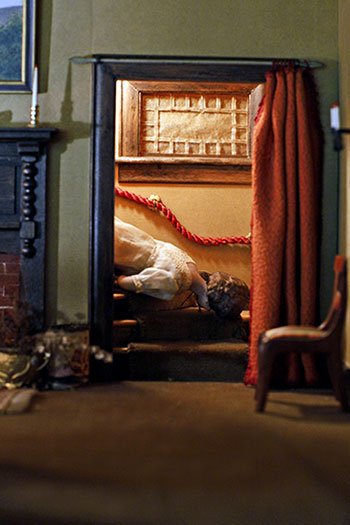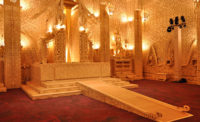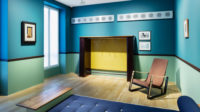In the 1940s, a Chicago divorcée who had never accepted the domestic role thrust upon her by the wealthy milieu she was born into in 1878 was at last able to embrace her true interest: forensic science—which (pace Sherlock Holmes) she more than helped to invent.
Frances Glessner Lee came to the discipline through a friend of her brother’s, a medical student and later teacher of legal medicine at Harvard University. In 1931, Lee helped to establish the Department of Legal Medicine there, the first of its kind on this continent; in 1943, she became the first female captain of a police force (in New Hampshire, where her family had a summer place) and began work on a series of models to demonstrate the use of evidence at a scene of death whose cause might be accident, suicide, or murder. They were meant as teaching tools, to correct the too frequently careless practices of coroners and investigators.
The 19 surviving dioramas, available together to the public for the first time in the exhibit Murder Is Her Hobby: Frances Glessner Lee and the Studies of Unexplained Death (until January 28), are on exhibit in architect James Renwick Jr.’s 1859 gallery building, now a branch of the Smithsonian American Art Museum. They are displayed through windows in walls, for the most part, though some representing several rooms or whole buildings are in vitrines, and lit only to mimic the actual light level at the time of the death or its reported discovery—the gray dimness of dawn coming through windows, the red glow of a fire from the open door of a wood stove, the tiny bulb of a tiny lamp.

Image courtesy Office of the Chief Medical Examiner
Labels give the statements made to the police by the discoverer of the body in each case, allowing viewers to play detective. For instance, in Living Room (1941), a woman’s “body” (a little doll) is shown prone at the bottom of a stair, with the husband quoted saying he got up at 5 a.m. and found his wife that way. But the observer is welcome to notice that a table lamp in the living room she had not yet reached is on, though he allegedly was just heading down when he found her, and that cigarette butts have overflowed the ashtray onto the tabletop, as if someone sat in that chair and pondered his next move (the rest of the room is in perfect order, suggesting that this is no holdover from their domestic evening together—though a basket of knitting sits neatly on the couch). But you can only guess. Conclusions are not given, because the Nutshell Studies of Unexplained Death, as they are known, are still actively used as teaching tools, and solutions would constitute a cheat sheet.
While I overheard many at the jammed show engaged in whodunit, there were those wondering why Lee had chosen to miniaturize these scenes, which cost as much to build (at her own expense) as whole houses of the time. One answer might be that, if they were lifesize, they could not easily be accommodated in classrooms. (Now, a VR version can also be accessed on mobile devices.) Another possible answer is sheer love of the miniature, a pleasure known to almost everyone, whether they played with GI Joe or read T.H. White’s Mistress Masham’s Repose. Those cigarette butts are about 1/8 of an inch long, and Lee rolled them herself, with real tobacco, burning the ends (photographs in the exhibit show her working with tweezers). Her embodied scenes may be less intricate than the carved rosary bead (ca. 1500) at the Cloisters that shows the Adoration of the Magi in the round at about 2 inches high, but they are expressive in an immediate way as commentary on somewhat more than crime or its absence, about both class and female roles.
“Men are afraid that women will laugh at them. Women are afraid that men will kill them,” is a statement frequently quoted and attributed to Margaret Atwood. Not all the corpses here are female or, necessarily, murder victims, but Lee does mean us to see the uses to which women are put by men. There is a prostitute fully clothed, on her back with her feet over the edge of an empty tin-lined tub, cold water running from the faucet into her face and mouth (Dark Bathroom, 1944-48). Kitchen (1944-46) shows a woman laid flat near the open door of her round-cornered refrigerator, an ice-cube tray next to her head, and a myriad of domestic tasks laid out around her like a picture of her days—an open ironing board with the iron on it, a rolling pin and board on the table next to a bowl of dough, potatoes on the ledge of the sink, a pie sitting on the open door of a gas oven, laundry on the line outside the window (including a minute bra and hankies).

Image courtesy Office of the Chief Medical Examiner
Even the wallpaper echoes the theme, its pattern featuring a woman with a broom or butter churn. The doll corpse could have died of overwork, though clues suggest suicide (which might amount to the same thing) as well as murder and accident. In the grimly sordid Log Cabin (1942), beer bottles litter the floor, one man sits by the wood stove, and the other lies under the bedcovers next to a woman who shared her destitute life with them—now over. I haven’t read Lee’s biography, but one would guess she was not overfond of men except as colleagues and companions.
She got to reject her female role as foisted upon her, but in her chosen work flagrantly employed the most “feminine” of arts to exemplify her gritty subject—knitting stockings on pins to clothe her little stiffs, for instance—and one cannot help feeling this as commentary in itself. She could easily have been laughed out of the station house.
Being rich didn’t hurt. Her fellow Chicago socialite Narcissa Thorne had won acclaim making a spectacular dollhouse (in the collection of the Art Institute of Chicago), its many rooms all luxe and grandeur—and unoccupied, as after a dirty bomb. Forlorn though the rooms may look, they avoid a problem familiar to anyone who ever played with dolls: their inert, bland faces. They’re already zombies, and one wishes the figures here were not as impassive as architectural scalies. One also wishes, despite the straight pins used as knitting needles, that the trace of clumsiness always evident in miniatures could be refined out—that the tailor of Gloucester’s mice could be employed to sew, weave, and manufacture.
Otherwise, regarding miniaturization, it should be noted that the attempt to make a world to scale immediately removes it from the literal and places it in the realm of representation. It is in this realm of “likeness”—the metaphorical—that art becomes possible.
The exhibition runs through January 28, 2018, at the Renwick Gallery of the Smithsonian American Art Museum.













